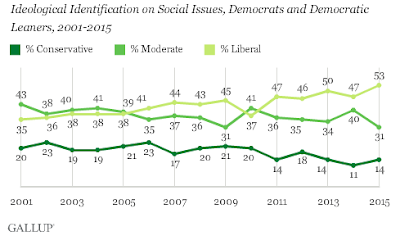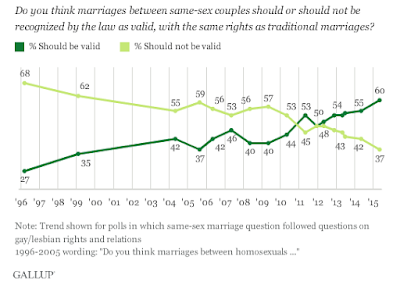In a very interesting twist, a recent poll by Pew shows how American's views on social issues has changed over the past 15 years. While both sides of the political spectrum seek to appeal to their traditional bases, this poll suggests that the political leaning of the United States as a whole may be evolving.
Here is the first question in the poll:
"Thinking about social issues, would you say your vies on social issues are very conservative, conservative, moderate, liberal or very liberal?"
For the first time in Gallup records dating back to 1999, the number of very conservative and conservative respondents and liberal and very liberal respondents was tied, each coming in at 31 percent with moderates coming in at 33 percent. Here is a graphic showing the results of the same polling question back to 1999 showing how the share of social liberals has grown and the share of social conservatives has declined:
In the latest annual poll, 5 percent of Americans declared themselves as very liberal, down from a recent high of 9 percent (in 2009, 2010 and 2012). Twenty-six percent of Americans declared themselves as conservative, down from a peak of 33 percent in 2009, 33 percent declared themselves as moderate, down from a peak of 39 percent in 2005, 21 percent declared themselves liberal, down from a peak of 23 percent in 2011 and 10 percent declared themselves as very liberal, tied with 2014 for the highest percentage in the past 15 years. The percentage of very liberal Americans is up significantly from its lows of 4 percent in both 1999 and 2003.
Here is an interesting graphic that looks at the percentage of Republicans and Republican leaners who describe themselves as conservative, moderate or liberal on social issues:
It is interesting to see that the 53 percent of Republicans that describe themselves as social conservatives is the lowest since 2001, well below the peak of 67 percent back in 2009, this, despite the Republican Party's strong objections to the Obama Administration.
Pew explains that these changes in the degree of social liberalism are mainly a result of an increasing number of Democrats who describe themselves as liberal rather than moderate and likely reflects the shift of Democrat attitudes on social economic and political issues further toward the left as we see on this graphic:
Changes in social liberalism are evident in how Americans feel about issues like same-sex marriage (60 percent approval in 2015 compared to 27 percent in 1996) as shown on this graphic:
…the legalization of marijuana with 51 percent approval in 2015 compared to 34 percent in 2004 and the impact of immigrants on the United States as shown on this graphic:
It is believed that these shifts are due to changing demographics. As an older, more conservative demographic cohort passes on to their great reward in the skies and younger, more socially liberal Americans replace them, attitudes have morphed. This change will have a significant impact on the 2016 election cycle as candidates adjust their platforms to appeal to a more socially liberal electorate. At the very least, this swing in the political winds will have a particular impact on Republican candidates who will find themselves needing to be somewhat less strident about their conservative social stance if they want to appeal to a broader audience that has become more socially liberal.
Click HERE to read more of Glen Asher's columns
You can publish this article on your website as long as you provide a link back to this page.






Be the first to comment